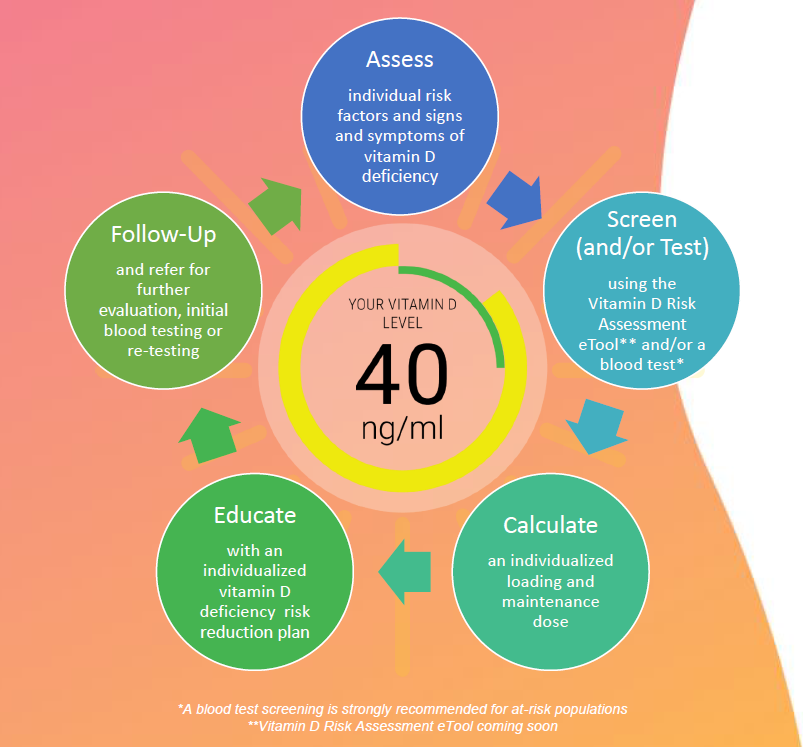Published on June 22, 2022
How many suffer with vitamin D deficiency related diseases? What can be done to change this? Introducing the Vitamin D Solution Cycle of Best Practices.
Key Points
- A new editorial by Cavoretto and Vigano has just been published online (July 2022) to call attention (once again) to the need for routine vitamin D assessment and supplementation
- Through GrassrootsHealth’s D*action participants’ vitamin D testing and implementation of the educational tools and resources, certain steps that have been identified as essential to ensuring the right dose of vitamin D and/or the right routine for individuals to implement in order to achieve and maintain their target vitamin D level. Those steps were previously published in the IRB-approved translational research guide, The Know “D” Number: Patient and Provider Guide for Understanding Vitamin D Testing & Results, and along with SBIRT, were used and adapted to develop a public health model for addressing vitamin D deficiency, called The Vitamin D Solution Cycle of Best Practices (VDCBP).
- Anyone, practitioners and individuals alike, can use these steps to create a protocol that suits their unique vitamin D needs
 A new editorial by Cavoretto and Vigano has just been published online (July 2022) to call attention (once again) to the need for routine vitamin D assessment and supplementation, especially in pregnancy. The authors also focus on the need for the proper design of vitamin D studies. This call to action follows on the back of the Tamblyn et al. paper reviewed last week, which found that women who were vitamin D deficient (with levels below 20 ng/ml or 50 nmol/L) at the beginning of pregnancy had a 94% significantly increased risk of miscarriage compared to women whose levels were 30 ng/ml (75 nmol/L) or higher.
A new editorial by Cavoretto and Vigano has just been published online (July 2022) to call attention (once again) to the need for routine vitamin D assessment and supplementation, especially in pregnancy. The authors also focus on the need for the proper design of vitamin D studies. This call to action follows on the back of the Tamblyn et al. paper reviewed last week, which found that women who were vitamin D deficient (with levels below 20 ng/ml or 50 nmol/L) at the beginning of pregnancy had a 94% significantly increased risk of miscarriage compared to women whose levels were 30 ng/ml (75 nmol/L) or higher.
It is obvious, for health reasons including and beyond pregnancy, that the issue of vitamin D deficiency has not been fully addressed for the population at large. While many GrassrootsHealth participants have done a fantastic job at taking steps to ensure their own adequate levels of vitamin D, many around them are most likely not – and are likely not even aware of the issue!
“…there is no reason to accept deficiency of vitamin D when it is avoidable through simple and safe measures!”
Please share this message far and wide…
The Same Messages were Stated by GrassrootsHealth Scientists, Almost 15 Years Ago
In 2008, the GrassrootsHealth Scientists’ Call to D*action was published and endorsed by 40 international vitamin D scientists (now 48) with several of the same messages. It was upon this Call to D*action that the GrassrootsHealth D*action project was initiated, to educate the public of the importance of vitamin D, with special attention to the need for testing in order to achieve and maintain a target vitamin D level of 40-60 ng/ml (100-150 nmol/L). The Call to D*action is based on these main points:
- Vitamin D supplementation to achieve target vitamin D levels of 40-60 ng/ml is safe and inexpensive
- Avoiding and/or correcting vitamin D deficiency and insufficiency can reduce the risk of many diseases and improve overall health
- Results of maintaining adequate vitamin D levels could include a significant reduction in health care costs and a more productive workforce
- Based on the evidence we now have at hand, action is urgent
“The D*action project has as its purpose to serve as a model for public health action on vitamin D.”
What is this Model of Action?
Through individual participants’ vitamin D testing and implementation of the educational tools and resources offered by GrassrootsHealth, there are certain steps that have been identified as essential to ensuring the right dose of vitamin D and/or the right routine for individuals to implement to achieve and maintain their target vitamin D level. Those steps were previously published in the IRB-approved translational research guide, The Know “D” Number: Patient and Provider Guide for Understanding Vitamin D Testing & Results in March of 2022.
The Know “D” Number: Patient and Provider Guide for Understanding Vitamin D Testing & Results and SBIRT (below) were used and adapted to develop a public health model for addressing vitamin D deficiency, called The Vitamin D Solution Cycle of Best Practices (VDCBP), by Beth Sanford, MSN, RN as part of her doctoral project with GrassrootsHealth.
SBIRT’s public health model of delivering early intervention and treatment through screening, brief intervention, and referral to treatment, addresses individuals already having a health condition as well as those with the potential to develop the health condition. As adapted from SBIRT, the Vitamin D Solution Cycle of Best Practices incorporates the components of pre-screening, screening, brief intervention, and referral for further evaluation or treatment, including a vitamin D [25(OH)D] blood test, into steps titled: Assess, Screen, Calculate, Educate, and Referral (outlined below). Each of these components is explained in depth in the Know “D” Number Patient and Provider Guide to Understanding Vitamin D, Testing & Results.
Anyone, practitioners and individuals alike, can use these steps to create a protocol that suits their unique vitamin D needs:
- Assess for individual and population risk factors as well as signs and symptoms of vitamin D deficiency
- Screen using The GrassrootsHealth Vitamin D Risk Assessment e-Tool (Coming Soon!) and/or a vitamin D blood test
- Calculate a vitamin D supplement loading dose and/or a maintenance dose needed to achieve and maintain the target level (using the Vitamin D*Calculator)
- Educate with an individualized vitamin D deficiency risk reduction plan, which includes:
o Vitamin D supplementation routine based on the dosing determined above
o Incorporating a safe sun and/or UVB exposure routine based on skin type, lifestyle, and social determinants of health
o Maintaining a healthy diet to maximize vitamin D absorption or co-nutrient supplementation - Refer for a blood test or follow-up test to evaluate the individual’s response to the dosing routine (follow-up testing should be done every 3-6 months until the target level is achieved; then, as needed to maintain recommended levels)
“There is enough evidence to support the need for change by implementing what we have shown to work, from the D*action project, into practice. D*action has demonstrated that our methods of testing and education are effective at improving vitamin D levels – let’s help these findings become fully utilized and implemented in clinical practice, for public health, and for use of individuals.”
What Happens When the Cycle is Not Completely Utilized?
A publication by Kerber et al. looked at trends of vitamin D testing and levels over a 16 year period among children and teen residents of Olmsted County, Minnesota. They found that, regardless of a 42-fold increase in the amount of vitamin D testing done, vitamin D deficiency/insufficiency (levels below 20 ng/ml or 50 nmol/L) among those tested remained stable, with an increased incidence of deficiency/insufficiency overall.
Several reasons are likely to contribute to this problem:
- Current recommendations for vitamin D intake are too low – most people are simply not taking enough vitamin D to reach the recommended level of 40-60 ng/ml (100-150 nmol/L), or even to correct a deficiency
- Everyone responds differently to vitamin D, so that the same dose recommendation will not achieve the same effect for all taking it
- The target vitamin D level is usually set too low, which also leaves little room for seasonal fluctuation in vitamin D levels
- Re-testing after initial supplementation and adjusting vitamin D intake to achieve the target level is lacking
The Vitamin D Solution Cycle of Best Practices, and companion translational research guide, Know “D” Number Patient and Provider Guide to Understanding Vitamin D, Testing & Results together fill the gap to increase healthcare provider confidence in implementing vitamin D best practices resulting in adequate vitamin D levels for all.
Take steps for your own vitamin D health by ensuring optimal levels – for your family and loved ones as well – by measuring at home today.







